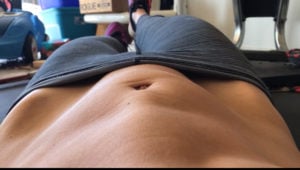A while back, I wrote a blog about myths of exercise during pregnancy. The point of this article was to urge women to exercise throughout pregnancy. We are finding more and more benefits of exercise during the pregnancy daily in research including things like decreased risk of gestational diabetes, decrease in blood pressure, increased APGAR scores in newborns, decreased risk of unplanned c-section and faster healing rates post delivery and so much more! Please take a look here at my article to dive a little deeper into the wonderful benefits of exercise during pregnancy.
Today we look at the other side of the story. I continue to be surprised at the general lack of education and resources on exercise for moms. I either see fear-mongering, with blog or accounts scaring women out of exercise or conversely, I see social media accounts that take the above-mentioned research, and capitalize on the importance of exercise, pushing moms to work out to “prep for delivery” or with the slogan to “get their bodies back quickly” with no mention of the potential problems and damage that could occur.
I want to take a moment to highlight my three “things to avoid” that I discuss with each of my patients as they navigate their exercise choices during pregnancy and postpartum exercise.
The things to avoid we will discuss today are not your common sense, obvious things. Of course, any exercise that causes dehydration, overheating and trauma/force to our pregnant bellies need to be avoided.
Today, we are going to discuss the more sneaky problems. These things are more like little thieves in the night. They come up slowly, quietly, undetected or just straight up ignored. They sneak up, entering in sometimes in places we would have never thought. And just like thieves, they come and go, leaving the damage behind for us to find later. Causing many moms saying things like “I wish I knew then.”
Our First Thief
Coning/Doming – Coning of our abdomen is the physical manifestation of improper pressure management and overactivation of our outta abdominal layer. Here are a few picture of coning for your pleasure:
Above: my belly with something as simple as lifting my leg
Me again. Alien in my belly? No. Just me hanging from a bar.
A common pathology associated with coning during and after pregnancy is diastasis recti (DR). Take a looksie here for a more in-depth discussion on exactly what DR is in a blog I wrote a few months back. DR is common and NORMAL during pregnancy, but our abs should return to a normal length after birth. Sometimes this is not the case and leaves mommas with abs muscles that are too far apart due to a lengthening of our abdominal tissue. DR causes a whole slew of issues and is something that needs to be treated if it persists. Unfortunately, there is nothing we can do to fully prevent DR but there are exercises and choices that are made that can greatly increase our likelihood of acquiring it! As a therapist and coach, any time coning occurs, extra stress and pressure are being put on our abs, consequently, stretching out our tissue more than it already is.
I would argue, any position, exercise or drill that results in coning is unsafe and requires modification. It’s like a rubber band that is stretched too often/too much, at some point, can’t return to its normal state and stays stretched out. When in doubt, look at your belly. Have someone look for you. You notice doming? Not the end of the world, but allowing yourself to perform exercises over and over that result in coning can leave you with elongated tissue that can sometimes never go back.
Our Second Thief
Urinary Leakage – Something that is not discussed enough and when we do talk about it, we laugh it off with other women as we line up to pee before we box jump or double under. I feel as though I want to get this tattooed on my forehead, URINARY LEAKAGE IS NOT NORMAL and not something we have to live with just because we had a baby. Urinary leakage is a symptom of poor pelvic health and again, a mismanagement of pressure. During pregnancy, leakage is a hard stop on exercise as you are creating poor pelvic habits and fatiguing a muscle group that already is having to support more weight than normal. Taking part in an exercise that causes urinary leakage is inappropriate during pregnancy.
Our Third Thief
Pelvic Pressure/Pain – During my first pregnancy, I remember running during a warm-up (waddling more like it) and feeling weird pressure and uncomfortable as I went. I distinctly remember continuing on because that’s what everyone else was doing and I knew the distance was short. There was no pain, but it also didn’t feel awesome either. Pressure/pain in our pelvis area is exactly that. Pressure. Our pelvic floor being pressed on and pushed excessively. Pressure and pain in our pelvis is absolutely a yellow flag. Just like our rubber band, our pelvic floor, if put under load over and over will eventually weaken and can cause postpartum urinary and fecal incontinence and even pelvic organ prolapse.
Be on guard. Be watchful.
Don’t ignore symptoms just because at the moment everything is fine. Ignoring the signs above is just allowing the thief open passage into our lives to potentially wreak havoc and mayhem on our abs and on our pelvic floor.
There are so many activities that of course, we can do, but should we? Assessing “risk versus reward” for every exercise is a must during pregnancy. Putting up safeguards against these thieves can allow for faster return to sport and a potential decrease in complications post pregnancy.
Finding a personal trainer well versed in pregnancy and postpartum athleticism is a wonderful idea, to help you navigate through this crazy season of life. Have any of the symptoms discussed? Find a pelvic floor or women’s specific therapist to help you recover properly!
As always, follow along on Instagram at @dr_brookemiller for similar posts, education, and information on pregnancy and postpartum exercise and recovery.


